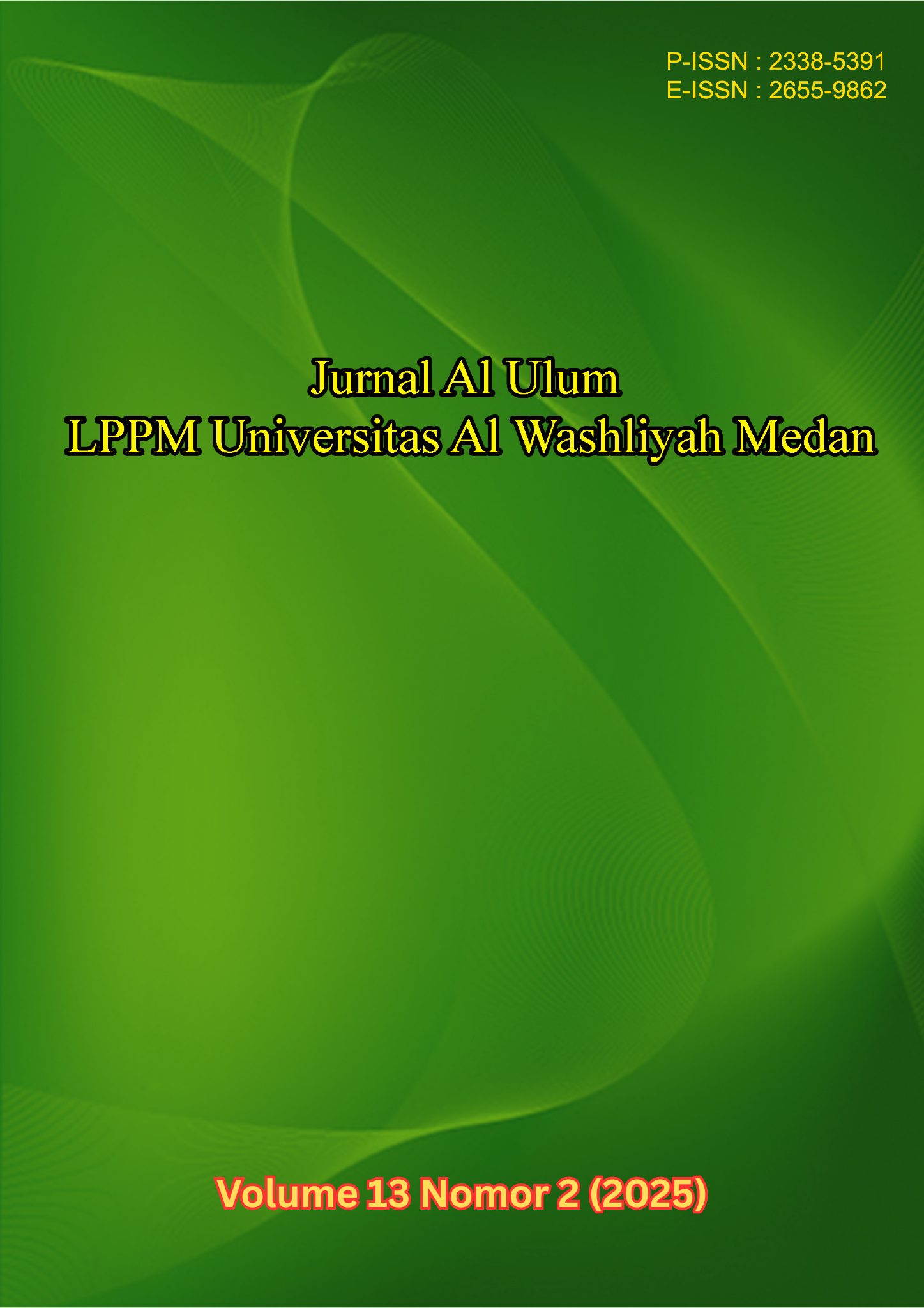PENGARUH SISTEM LAMPU LED DAN REFLEKTOR DENGAN MENGGUNAKAN METODE DEEP FLOW TECHNIQUE PADA TANAMAN KALE (Brassica Oleracea Var. Sabellica)
DOI:
https://doi.org/10.47662/alulum.v13i2.906Keywords:
DFT, Hydroponics, LED Lights, Photosynthesis, ReflectorsAbstract
Kale (Brassica oleracea var. sabellica) is a high-value vegetable that requires adequate lighting to support photosynthesis, especially when cultivated using a hydroponic system. This study aimed to examine the effect of LED lighting and reflector use on kale growth using the Deep Flow Technique (DFT). The research was conducted in September 2024 at the Horticultural Research Center, MARDI Serdang, Malaysia, using a Completely Randomized Design (CRD) with three treatments: 4 lamps (4L), 4 lamps with reflector (4 LMR), and 5 lamps (5L), each repeated five times for a total of 1,000 plants. Observed parameters included plant height, number of leaves, chlorophyll content, and Leaf Area Index (LAI). The results showed that the 4 LMR treatment produced the best growth, with the highest number of leaves, the highest chlorophyll content, and good LAI values. The use of reflectors effectively increased light absorption efficiency and photosynthesis. In contrast, the 4L treatment showed the lowest growth due to poor lighting and nutrient deficiencies. Overall, the MARDI reflector proved effective in enhancing kale growth in a DFT hydroponic system.
References
Baur, S., Klaiber, R. G., Koblo, A., & Carle, R. (2014). Effect of different washing procedureson phenolic metabolism of shredded, packaged iceberg lettuce during storage. Jurnal of agricultural and food chemistry, 52(23), 7017-7025
Doni, R., dan Rahman, M. (2020). Sistem monitoring tanaman hidroponik berbasis IoT (Internet of Thing) menggunakan Nodemcu ESP8266. J-SAKTI (Jurnal Sains Komputer dan Informatika), 4(2), 516-522.
Fitmawati, F., Isnaini, I., Fatonah, S., Sofiyanti, N., & Roza, R. M. (2018). Penerapan teknologi hidroponik sistem deep flow technique sebagai usaha peningkatan pendapatan petani di Desa Sungai Bawang. Riau Journal of Empowerment, 1(1), 23-29.
Gregoryan, M., Andjarwirawan, J., & Lim, R. (2019). Sistem kontrol dan monitoring pH air serta kepekatan nutrisi pada budidaya hidroponik jenis sayur dengan teknik deep flow techcnique. Jurnal Infra, 7(2), 1-6.
Hernita, D., Poerwanto, R., Susila, A.D., & Anwar, S. (2012). Penentuan Status Hara Nitrogen pada Bibit Duku. Jurnal Hortikultura, 22(1), 29-36
Ikrarwati., Zulkarnaen, I., Fathonah, A., Nurmayulis., & Eris, F. R. (2020). Pengaruh Jarak Lampu LED dan Jenis Media Tanam Terhadap Microgreen Basil (Ocimum basilicum L.). Agropross, National Conference Proceedings of Agriculture, pp.1-16
Indirasari, S. S. (2019). The Linkages of Laboratory Facilities and Motivation to the Learning Outcomes of emarang Hight School. Semarang: Students journal of Innovative Science Education.
Mikrajuddin Abdulah. 2017. Keefektifan Spektrum Cahaya Terhadap Pertumbuhan Tanaman Kacang Hijau. Jurnal Ilmiah Penelitian dan Pembelajaran Fisika, 4(2), 93-102
Nurdin, SQ. (2017). Mempercepat Panen Sayuran Hidroponik. PT Agromedia Pustaka. Jakarta.
Pambayun, R. R., & Sumarna, S. (2016). Otomatisasi Pengendalian Suhu Pada Greenhouse. Jurnal Ilmu Fisika dan Terapannya, 5(7), 401-409.
Restiani, A.R., Triyono, S., Tusi A., & Zahab, R. (2015). Pengaruh Jenis Lampu Terhadap Pertumbuhan dan Hasil Produksi Tanaman Selada (Lactuca sativa L.) dalam Sistem Hidroponik Indoor. Jurnal Teknik Pertanian Lampung, 4(3): 219-226.
Sa’diyah, A. A., & Pudjiastuti, A. Q. (2017). Faktor penentu produksi sayuran dataran tinggi di Kecamatan Sukapura Kabupaten Probolinggo. Agriekonomika, 6(2),186-96.
Samadi, B. (2013). Budidaya Intensif Kailan Secara Organik dan Anorganik. Pustaka Mina. Jakarta.
Sayekti, S., Esti, H., & Moh. M. (2015). Pengaruh Intensitas Cahaya Terhadap Kandungan klorofilA dan -C Zooxanthellae Dari Isolat Karang Lunak Zoanthus sp. Jurnal maspari, 9(1), 61-68.
Subandi, M., Nella, P.S., & Budy, F. (2015). Pengaruh Berbagai Niai EC (Electrical Coductivity) terhadap Pertumbuhan dan Hasil Bayam (Amaranthus sp) pada Hidroponik Sistem Rakit Apung (Floating Hydoponic Syistem). Jurnal Agroeknologi, 9(2), 136 – 152
Syafriyudin, N.T.L. (2015). Analisis pertumbuhan tanaman krisan pada variable warna cahaya lampu LED. Jurnal Teknologi, 8(1), 83-87.
Syahadat, R. M., Aziz, S. A. (2020). Hubungan jumlah bunga, jumlah daun, jumlah anak daun, jumlah cabang, dan tinggi tanaman terhadap pertumbuhan bibit tanaman kemuning (Murraya paniculata (L.) Jack). Jurnal Lanskap Indonesia, 5(1): 23-25.
Sutoyo (2011). Foto periode dan pembungaan tanaman. Jurnal Buana Sains,11(2), 137-144.
Wardhana, I., Hasbi, H., & Wijaya, I. (2016). Respons Pertumbuhan dan Produksi Tanaman Selada (Lactuca sativa L.) pada Pemberian Dosis Pupuk Kandang Kambing dan Interval Waktu Aplikasi Pupuk Super Bionik Cair. Jurnal Agritrop Ilmu Pertanian, 1(1), 165-185.
Downloads
Published
Issue
Section
License
Copyright (c) 2025 Lena Afrilia, Dafni Mawar Tarigan, Khairul Anuar, Munirah Mohamad

This work is licensed under a Creative Commons Attribution 4.0 International License.









